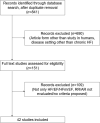Prognostic value of reverse remodelling criteria in heart failure with reduced or mid-range ejection fraction
- PMID: 34002938
- PMCID: PMC8318429
- DOI: 10.1002/ehf2.13396
Prognostic value of reverse remodelling criteria in heart failure with reduced or mid-range ejection fraction
Abstract
Aims: Reverse remodelling (RR) is the recovery from left ventricular (LV) dilatation and dysfunction. Many arbitrary criteria for RR have been proposed. We searched the criteria with the strongest prognostic yield for the hard endpoint of cardiovascular death.
Methods and results: We performed a systematic literature search of diagnostic criteria for RR. We evaluated their prognostic significance in a cohort of 927 patients with LV ejection fraction (LVEF) < 50% undergoing two echocardiograms within 12 ± 2 months. These patients were followed for a median of 2.8 years (interquartile interval 1.3-4.9) after the second echocardiogram, recording 123 cardiovascular deaths. Two prognostic models were defined. Model 1 included age, LVEF, N-terminal pro-B-type natriuretic peptide, ischaemic aetiology, cardiac resynchronization therapy, estimated glomerular filtration rate, New York Heart Association, and LV end-systolic volume (LVESV) index, and Model 2 the validated Cardiac and Comorbid Conditions Heart Failure score. We identified 25 criteria for RR, the most used being LVESV reduction ≥15% (12 studies out of 42). In the whole cohort, two criteria proved particularly effective in risk reclassification over Model 1 and Model 2. These criteria were (i) LVEF increase >10 U and (ii) LVEF increase ≥1 category [severe (LVEF ≤ 30%), moderate (LVEF 31-40%), mild LV dysfunction (LVEF 41-55%), and normal LV function (LVEF ≥ 56%)]. The same two criteria yielded independent prognostic significance and improved risk reclassification even in patients with more severe systolic dysfunction, namely, those with LVEF < 40% or LVEF ≤ 35%. Furthermore, LVEF increase >10 U and LVEF increase ≥1 category displayed a greater prognostic value than LVESV reduction ≥15%, both in the whole cohort and in the subgroups with LVEF < 40% or LVEF ≤ 35%. For example, LVEF increase >10 U independently predicted cardiovascular death over Model 1 and LVESV reduction ≥15% (hazard ratio 0.40, 95% confidence interval 0.18-0.90, P = 0.026), while LVESV reduction ≥15% did not independently predict cardiovascular death (P = 0.112).
Conclusions: Left ventricular ejection fraction increase >10 U and LVEF increase ≥1 category are stronger predictors of cardiovascular death than the most commonly used criterion for RR, namely, LVESV reduction ≥15%.
Keywords: Criteria; Heart failure; Prognosis; Reverse remodelling.
© 2021 The Authors. ESC Heart Failure published by John Wiley & Sons Ltd on behalf of European Society of Cardiology.
Conflict of interest statement
None declared.
Figures


References
-
- Aimo A, Gaggin HK, Barison A, Emdin M, Januzzi JL Jr. Imaging, biomarker, and clinical predictors of cardiac remodeling in heart failure with reduced ejection fraction. JACC Heart Fail 2019; 7: 782–794. - PubMed
-
- Koitabashi N, Kass DA. Reverse remodeling in heart failure—mechanisms and therapeutic opportunities. Nat Rev Cardiol 2011; 9: 147–157. - PubMed
-
- Halliday BP, Wassall R, Lota AS, Khalique Z, Gregson J, Newsome S, Jackson R, Rahneva T, Wage R, Smith G, Venneri L, Tayal U, Auger D, Midwinter W, Whiffin N, Rajani R, Dungu JN, Pantazis A, Cook SA, Ware JS, Baksi AJ, Pennell DJ, Rosen SD, Cowie MR, Cleland JGF, Prasad SK. Withdrawal of pharmacological treatment for heart failure in patients with recovered dilated cardiomyopathy (TRED‐HF): an open‐label, pilot, randomised trial. Lancet 2019; 393: 61–73. - PMC - PubMed
-
- Senni M, Parrella P, De Maria R, Cottini C, Böhm M, Ponikowski P, Filippatos G, Tribouilloy C, Di Lenarda A, Oliva F, Pulignano G, Cicoira M, Nodari S, Porcu M, Cioffi G, Gabrielli D, Parodi O, Ferrazzi P, Gavazzi A. Predicting heart failure outcome from cardiac and comorbid conditions: the 3C‐HF score. Int J Cardiol 2013; 163: 206–211. - PubMed
-
- Aimo A, Vergaro G, Castiglione V, Barison A, Pasanisi E, Petersen C, Chubuchny V, Giannoni A, Poletti R, Maffei S, Januzzi JL Jr, Passino C, Emdin M. Effect of sex on reverse remodeling in chronic systolic heart failure. JACC Heart Fail 2017; 5: 735–742. - PubMed
MeSH terms
LinkOut - more resources
Full Text Sources
Other Literature Sources
Medical

